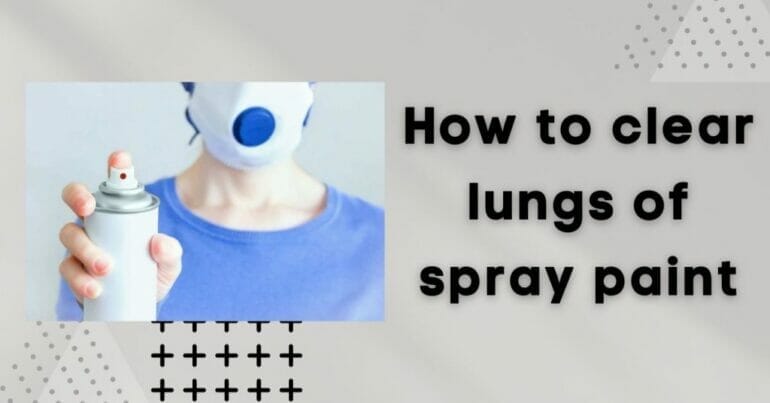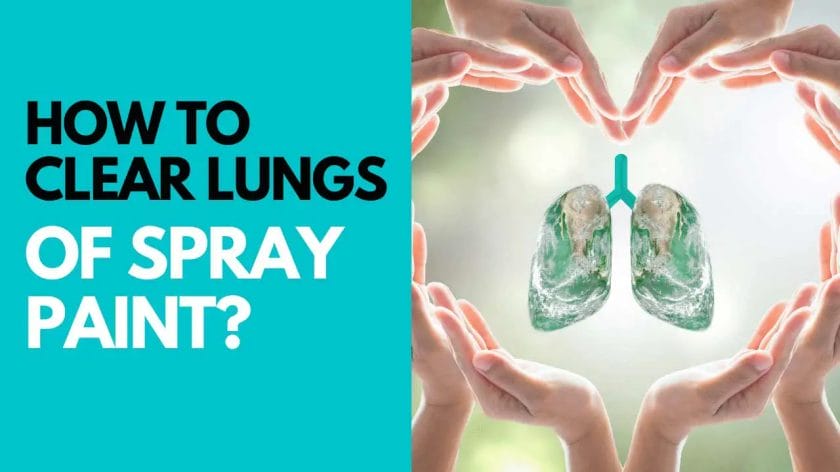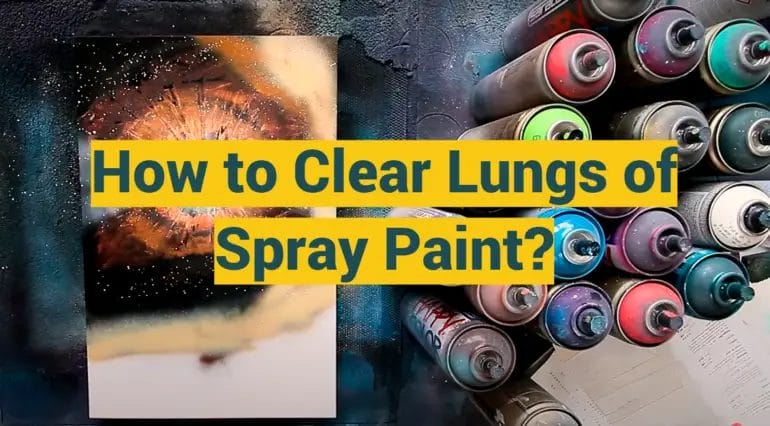If you’ve been exposed to spray paint fumes or have accidentally inhaled them, it’s important to take steps to clear your lungs and promote respiratory health. In this article, we’ll explore effective methods to help cleanse your lungs and alleviate any discomfort caused by spray paint inhalation. From staying hydrated and practicing deep breathing exercises to seeking medical advice when necessary, read on to discover how you can safely clear your lungs of spray paint.
One of the first steps in clearing your lungs of spray paint fumes is to stay hydrated. Drinking plenty of water helps to thin mucus and promotes productive coughing, allowing your body to effectively eliminate any toxins or irritants in your respiratory system.
Practicing deep breathing exercises can also be beneficial in clearing your lungs. Deep breaths help to expand the lungs, increase oxygen flow, and stimulate the cilia – tiny hair-like structures in your airways that help to trap and remove foreign particles. Regular deep breathing can aid in clearing out any residual spray paint particles in your lungs.
In addition to hydration and deep breathing, it’s crucial to be mindful of your environment. If possible, avoid further exposure to spray paint fumes and opt for well-ventilated areas. Open windows, use fans, or consider wearing a respiratory mask if you need to be in a painted area.
If you experience persistent or severe symptoms such as shortness of breath, chest pain, or coughing

Breathing Exercises to Cleanse and Detoxify Your Lungs from Spray Paint
Spray paint fumes can be harmful to your respiratory system, causing irritation and inflammation in your lungs. If you have been exposed to spray paint or any other harmful chemicals, it is important to take steps to cleanse and detoxify your lungs. One effective way to do this is through breathing exercises. In this section, we will explore some breathing exercises that can help you remove toxins from your lungs and promote better respiratory health.
1. Diaphragmatic Breathing
Diaphragmatic breathing, also known as deep belly breathing, is a simple yet powerful technique that can help cleanse your lungs. This technique focuses on expanding and contracting your diaphragm, the muscle located below your lungs.
To practice diaphragmatic breathing:
- Find a comfortable seated position and relax your body.
- Place one hand on your chest and the other hand on your abdomen.
- Inhale deeply through your nose, allowing your abdomen to rise as you fill your lungs with air.
- Exhale slowly through your mouth, drawing your navel towards your spine to fully empty your lungs.
- Repeat this pattern of deep inhalation and slow exhalation for several minutes, focusing on the movement of your abdomen.
Diaphragmatic breathing helps to optimize the oxygen exchange in your lungs, promoting detoxification and cleansing of toxins.
2. Pursed Lip Breathing
Pursed lip breathing is another effective breathing technique to cleanse and detoxify your lungs. It helps to prolong exhalation, allowing your lungs to fully expel toxins and stale air.
To practice pursed lip breathing:
- Sit in a comfortable position and relax your body.
- Inhale slowly through your nose for a count of two.
- Purse your lips as if you are about to blow out a candle.
- Exhale slowly through your pursed lips for a count of four.
- Repeat this pattern of inhalation and exhalation for several minutes, focusing on the sensation of your breath as it passes through your lips.
Pursed lip breathing helps to regulate your breathing pattern, improve lung function, and expel toxins from your lungs.
3. Alternate Nostril Breathing
Alternate nostril breathing, also known as Nadi Shodhana, is a yogic breathing technique that helps balance the energy in your body and cleanse your respiratory system.
To practice alternate nostril breathing:
- Sit comfortably with your spine straight.
- Place your left hand on your left knee and bring your right hand towards your face.
- With your right hand, bring your index and middle fingers to rest between your eyebrows.
- Close your right nostril with your right thumb and inhale deeply through your left nostril.
- Close your left nostril with your ring finger, release the right nostril, and exhale through it.
- Inhale through the right nostril, close it with your thumb, and exhale through the left nostril.
- Repeat this pattern, alternating the inhalation and exhalation through each nostril, for several minutes.
Alternate nostril breathing helps to clear your respiratory channels, remove toxins, and promote overall lung health.
In summary, breathing exercises can be a valuable tool in cleansing and detoxifying your lungs from spray paint and other harmful substances. Incorporate these techniques into your daily routine to support your respiratory health and promote toxin removal from your lungs. Remember to consult with a healthcare professional if you experience persistent respiratory symptoms or have underlying respiratory conditions.

Foods and Supplements to Remove Toxins from Lungs After Spray Paint Exposure
Exposure to spray paint fumes can have harmful effects on your respiratory system, especially your lungs. It is essential to take proactive steps to remove toxins from your lungs and support their detoxification process. Along with seeking medical attention if necessary, incorporating specific foods and supplements into your diet can aid in the detoxification process. In this section, we will explore some of these foods and supplements that can help remove toxins from your lungs after spray paint exposure.
1. Turmeric
Turmeric is a spice known for its powerful anti-inflammatory and antioxidant properties. It contains a compound called curcumin, which helps reduce inflammation and promote detoxification. Consuming turmeric regularly can support your lung health and aid in removing toxins. You can add turmeric to your meals or incorporate it into a warm, soothing turmeric tea.
2. Ginger
Ginger has been used for centuries for its medicinal properties, including its ability to support lung health. It has anti-inflammatory and antioxidant properties that can help cleanse your lungs and remove toxins. You can consume ginger by adding it to your meals, drinking ginger tea, or even chewing on raw ginger.
3. Garlic
Garlic is another natural remedy that can help remove toxins from your lungs. It contains sulfur compounds that have been shown to support the detoxification process. Garlic also has antimicrobial and anti-inflammatory properties, which can help reduce inflammation and protect your lungs. Incorporating garlic into your meals or taking garlic supplements can provide these benefits.
4. Green Leafy Vegetables
Green leafy vegetables, such as kale, spinach, and Swiss chard, are rich in antioxidants and essential nutrients that can support lung health. These vegetables help neutralize harmful toxins and reduce inflammation in the lungs. Including a variety of green leafy vegetables in your diet can help detoxify your lungs and promote overall respiratory health.
5. Vitamin C
Vitamin C is a powerful antioxidant that can help protect your lungs from oxidative stress and remove toxins. It supports the production of glutathione, a crucial antioxidant involved in the detoxification process. Consuming foods rich in vitamin C, such as citrus fruits, berries, and bell peppers, can enhance your lung health and aid in detoxification.
6. N-acetylcysteine (NAC)
N-acetylcysteine is a supplement commonly used to support respiratory health and aid in detoxification. It helps increase the production of glutathione, a powerful antioxidant that plays a vital role in removing toxins from the lungs. NAC can be beneficial in reducing the harmful effects of spray paint exposure on your respiratory system.
7. Milk Thistle
Milk thistle is a herb known for its liver-protective properties. However, it can also be beneficial for lung health and detoxification. Milk thistle contains a compound called silymarin, which has antioxidant and anti-inflammatory effects. This herb can help remove toxins from the lungs and support their overall health.
In summary, when exposed to spray paint fumes, it is crucial to take steps to remove toxins from your lungs. Incorporating foods and supplements such as turmeric, ginger, garlic, green leafy vegetables, vitamin C, N-acetylcysteine, and milk thistle can support the detoxification process and promote lung health. Remember to consult with a healthcare professional before making any significant changes to your diet or starting new supplements.

Importance of Staying Hydrated to Flush out Toxins from Your Lungs after Using Spray Paint
After using spray paint, it is essential to prioritize your health and take necessary steps to protect your respiratory system. Inhaling toxic fumes from spray paint can have harmful effects on your lungs. One effective way to help flush out these toxins and promote lung health is by staying hydrated. Let’s explore the importance of staying hydrated and how it can aid in detoxification.
1. Understanding the Risks
Spray paint contains various chemicals, such as volatile organic compounds (VOCs), which can be harmful when inhaled. These VOCs can irritate the respiratory system, cause dizziness, nausea, and even lead to long-term health issues. It is crucial to be aware of the risks associated with spray paint exposure and take appropriate measures to protect yourself.
2. Hydration and Detoxification
Water is essential for our overall health, and when it comes to detoxification, it plays a vital role. Staying hydrated helps your body flush out toxins through various elimination processes, including sweating and urination. By drinking an adequate amount of water, you support your body’s natural detoxification mechanisms, including the removal of toxins from your lungs.
3. Promoting Lung Health
Proper hydration is essential for maintaining healthy lungs. When you are well-hydrated, your body can produce enough mucus to protect your respiratory system from irritants. This mucus acts as a defensive barrier, trapping harmful particles, including paint fumes, and preventing them from reaching your lungs. Staying hydrated also helps thin out mucus, making it easier to expel any trapped irritants.
4. Flushing out Toxins
Drinking an adequate amount of water after spray painting helps your body eliminate toxins more efficiently. As you hydrate, your kidneys filter toxins out of your bloodstream and excrete them through urine. Additionally, water plays a crucial role in maintaining optimal lung function by keeping your airways moist and preventing dryness.
5. Tips for Staying Hydrated
To ensure you stay properly hydrated and aid in the detoxification process after using spray paint, consider the following tips:
- Drink at least 8 glasses (64 ounces) of water per day.
- Include hydrating foods in your diet, such as watermelon, cucumbers, and citrus fruits.
- Avoid excessive consumption of dehydrating beverages like alcohol and caffeinated drinks.
- Set reminders or use a water tracking app to help you stay on top of your hydration goals.
- Consider using a humidifier in your living space to help maintain optimal humidity levels and prevent dryness.
6. Conclusion
In summary, after using spray paint, it is crucial to prioritize your respiratory health. Staying hydrated plays a significant role in flushing out toxins from your lungs and promoting overall lung health. By maintaining proper hydration levels, you support your body’s natural detoxification processes and assist in eliminating harmful substances. Remember to drink an adequate amount of water daily and make it a habit to stay hydrated consistently.
Tips for Preventing Lung Damage While Working with Spray Paint
Spray painting can be a fun and creative way to enhance the appearance of various objects. However, it is important to prioritize your safety, especially when it comes to protecting your lungs from harmful fumes and chemicals that may be present in spray paint. In this section, we will discuss some valuable tips to prevent lung damage while working with spray paint.
1. Choose a Well-Ventilated Area
Working in a well-ventilated area is crucial to minimize your exposure to harmful fumes. Ideally, you should perform your spray painting tasks outdoors, where there is natural air circulation. If working indoors is unavoidable, make sure to open windows and doors to allow proper ventilation.
2. Wear Protective Gear
Always wear appropriate protective gear to shield your lungs from spray paint particles and fumes. A respirator or mask specifically designed for spray painting should be worn at all times. Look for masks that are labeled as N95 or N99, as these provide the highest level of filtration.
In addition to a mask, wearing safety goggles and disposable gloves is also recommended to protect your eyes and skin from any potential chemical contact.
3. Use a Spray Booth
If you frequently work with spray paint, consider investing in a spray booth. A spray booth is an enclosed area specifically designed for spray painting. It helps contain the fumes and particles, preventing them from spreading to other areas and minimizing your exposure.
4. Take Breaks and Work in Intervals
Painting for extended periods without breaks can increase your exposure to harmful fumes. To minimize the risk, take regular breaks and work in intervals. Step away from the painting area, go to a well-ventilated space, and allow your lungs to breathe fresh air.
5. Read and Follow Instructions
Before using any spray paint product, carefully read and follow the instructions provided by the manufacturer. Pay attention to any safety precautions mentioned, such as recommended ventilation, usage guidelines, and protective measures.
6. Store and Dispose of Paint Properly
When you are done with your spray painting project, ensure that you store any leftover paint in a cool and well-ventilated area. Follow the instructions on the paint can regarding storage temperature and disposal methods. Improper storage or disposal can lead to the release of harmful chemicals into the environment.
7. Maintain Good Personal Hygiene
After completing your spray painting tasks, it is essential to practice good personal hygiene. Wash your hands thoroughly with soap and water to remove any paint residue from your skin. Changing into clean clothes and avoiding touching your face can further minimize the chances of accidental ingestion or inhalation of spray paint particles.
8. Seek Professional Help if Needed
If you frequently work with spray paint or experience any respiratory symptoms such as coughing, wheezing, or shortness of breath, it is advisable to consult a healthcare professional. They can provide a proper evaluation and guide you on the best course of action to protect your lung health.
By following these tips, you can significantly reduce the risk of lung damage while working with spray paint. Prioritizing your safety and taking necessary precautions will allow you to enjoy the creative process while keeping your lungs protected.
FAQs
1. How can I clear my lungs of spray paint?
If you have accidentally inhaled spray paint fumes, it is important to get to fresh air immediately. Deep breathing exercises and staying hydrated can help your body naturally clear out the fumes. If you experience severe symptoms or difficulty breathing, seek medical attention.
2. What are the symptoms of inhaling spray paint?
Symptoms of inhaling spray paint fumes may include dizziness, headache, nausea, difficulty breathing, and irritation of the eyes, nose, or throat. If you experience these symptoms, move to a well-ventilated area and seek medical help if necessary.
3. How can I protect myself from inhaling spray paint fumes?
To protect yourself from inhaling spray paint fumes, it is important to work in a well-ventilated area or use a respirator mask. Covering your skin and wearing goggles can also help prevent direct contact with the paint. Additionally, following the safety instructions on the paint can and using it in a controlled manner can minimize the risk.
Conclusion:
In conclusion, effectively clearing your lungs of spray paint fumes is crucial for maintaining good respiratory health. By following a few simple steps, you can minimize the adverse effects and protect your lungs. Firstly, always wear a proper respirator mask when working with spray paint to prevent inhalation of harmful particles. Secondly, ensure proper ventilation in your workspace by opening windows or using fans. Additionally, taking regular breaks during painting sessions allows your lungs to recover and expel any accumulated toxins. Lastly, adopting a healthy lifestyle, including regular exercise and a balanced diet, can strengthen your respiratory system and aid in clearing your lungs.
Remember, protecting your lungs is a long-term commitment. By implementing these strategies, you can continue pursuing your creative projects while safeguarding your respiratory health. Don’t underestimate the importance of respiratory protection, as it directly impacts your overall well-being. Stay conscious of safety measures and prioritize your lung health for a healthier artistic journey!
